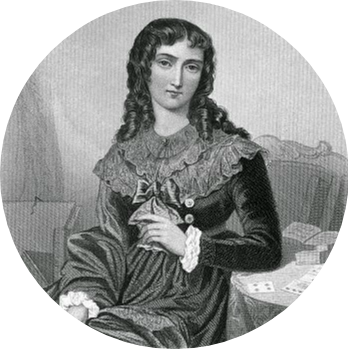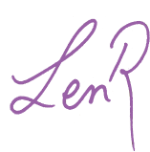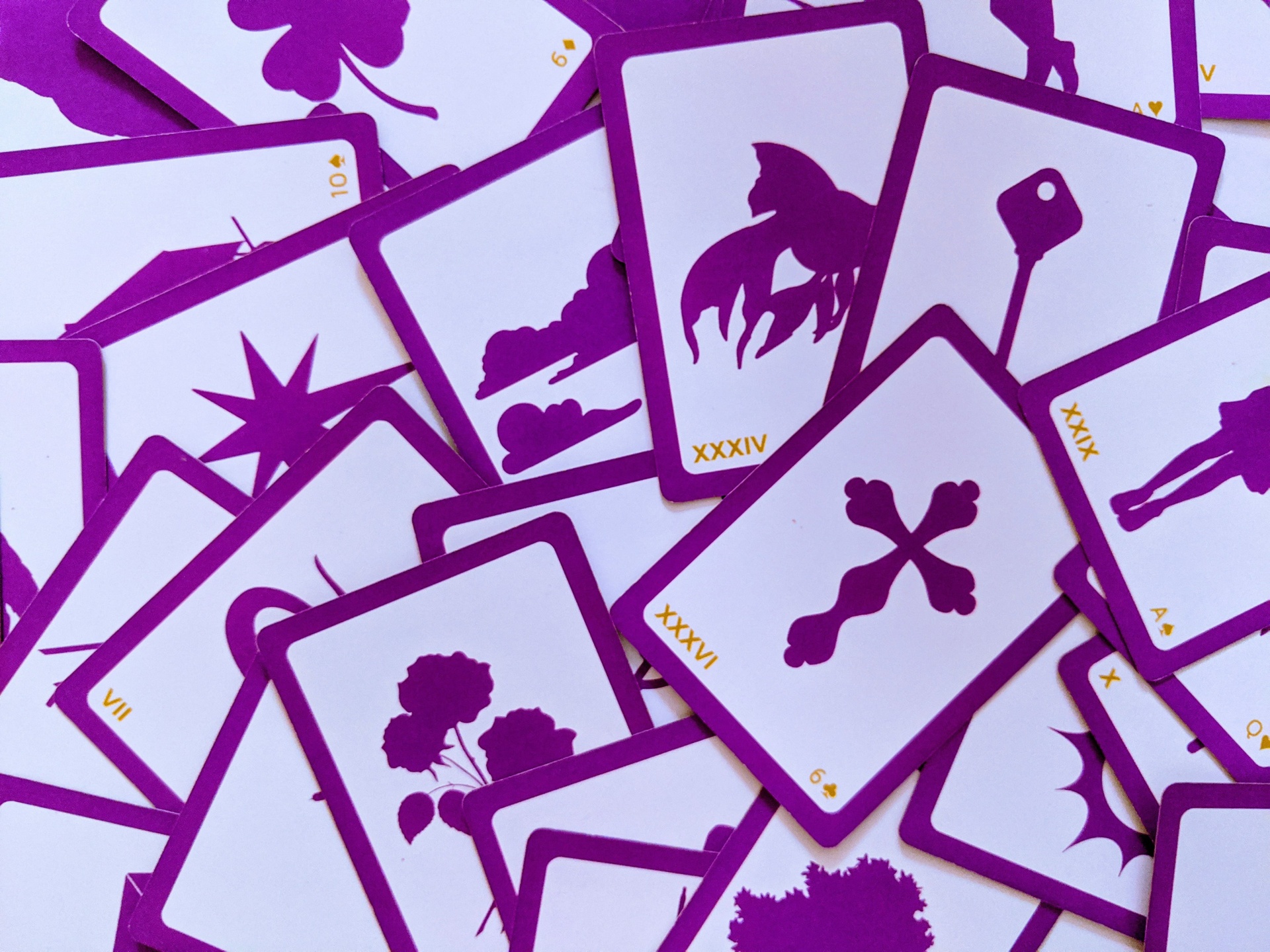
WHO WAS MLLE LENORMAND?
What comes to your mind when you hear “Lenormand oracle”? An ancient oracle? Gypsy Tarot cards? Fortune playing cards? …Or maybe you’ve never heard about it. Today, the deck we know as the Lenormand is in fact Le Petit Jeu de Mlle Lenormand which translates literally into “the small game by Mlle Lenormand.” It is a simplified version of what is thought to be the authentic Lenormand cards: Le Grand Jeu de Mlle Lenormand, or “the big game,” which is made up of 54 cards illustrated with complex and multidimensional symbolism. Despite the fact that Le Petit Jeu came later and is unlikely designed by Mlle Lenormand, it was largely popularized in Germany and spread throughout Europe to remain the favored version well into today.
EARLY HISTORY
The mysterious Mlle Marie Anne Lenormand was a famous – or perhaps infamous – French fortune teller who lived between the 18th and 19th centuries. She is considered to be one of the greatest cartomancers of all time, if not the greatest of all. Her predictions were so accurate they brought her fame and a large clientele from all walks of life including notably members of the French nobility like Josephine de Beauharnais who later became Empress Josephine as the wife of Napoleon Bonaparte, and other members of the ruling class of the day like the Russian Czar Alexander. Her career was not without troubles as her controversial interpretations sent her to jail on several occasions although for short periods each time.
Some believe that Mlle Lenormand did not design these cards and that she used instead the Tarot and other decks common in her day. Others argue that she ‘received’ her cards in her dreams which partly explains their power and popularity. Curiously, even as a prolific and controversial writer, she never wrote about her divination methods or left clues about her professional practice. But if she did not design these cards, why would they bear her name?
Mlle Lenormand’s fame – and notoriety – created great interest in cartomancy across Europe. In 1845, about two years after Lenormand’s death, a clever and enterprising French publisher, Grimaud, still in operation today, produced a deck called “Le Grand Jeu de Mlle Lenormand”. Grimaud claims the deck is based on information disclosed by a student of the late Mlle Lenormand. The Grand Jeu is made up of 54 cards, with illustrations rich in symbolism. Scenes from Greek mythology, constellations, geomantic symbols, Kabbalah letters, talismans, playing cards and flowers illustrate this stunning and obscure deck.
POPULARIZING LE PETIT JEU
Over the next few years, more decks started to be published bearing the name of Mlle Lenormand. The 36-card Petit Jeu was created as a concise version of the Grand Jeu while remaining faithful to its intricate symbolism. The Petit Jeu continues to be the more popular deck of the two today, while the Grand Jeu is much less used and seldom known about.
Around 1850, decks with simpler designs began to appear in Germany. These decks have 36 cards numbered sequentially, each bearing a single image. It is said they were based on a deck designed in Nuremberg, Germany, in the estimated year of 1800. The numbers on the cards were supposedly used for a dice game. Since then, it became standard to include the small playing card images as part of the greater card image and sold with a brief instruction booklet; a format known today as the Blue Owl Lenormand deck – in contrast to the Red Owl Lenormand which has quotes instead of the playing card insets.
The simple symbols on this version of the cards made the deck very popular in Germany and enabled it to spread throughout the rest Europe. It is probably because of this simple deck’s origin that divination with Lenormand remains today most popular in Germany despite the fact that Mlle Lenormand lived and practiced in France.

NOT LIKE THE TAROT
So how is Lenormand’s deck different from the Tarot? Lenormand’s cards tap into our natural psychic ability, which the Tarot often fails to do, at least not without serious and repeated practice. I am deeply versed in the Tarot, and while its symbolism can be intriguing, I cannot immerse myself in it the way I can with Lenormand’s cards.
The Tarot and the way it is used in layouts has a two-dimensional character that prevents the reader from experiencing the divinatory space in the way one can with Lenormand’s deck. Her cards have a mysterious way of going far beyond the single card meaning into depths that come from weaving the cards together. When it comes to alchemizing card symbols and meanings, the Tarot only begins to scratch the surface. Lenormand’s cards weave a multidimensional story from their combination with surrounding cards and in a manner of free-form that truly liberates the interpretive mind.
And yet, the cards are so easy to learn from our immediate connection with their symbol. For example, what comes to your mind when you look at the image of a dog? Obviously the actual animal, or perhaps another pet, but what else? Think of what dogs are like, or what we say about them? “Dogs are man’s best friend” is a popular saying. They inspire loyalty, friendship, and companionship. They also protect and play with us. So, the Dog card easily associates with friendship, trust and can, more simply, represent a pet.
This simple yet powerful approach to using symbolism is what makes the Lenormand’s oracle so enjoyable and easy to read. The Tarot deck, on the other hand, has esoteric imagery on nearly every card that must first be learnt then assimilated before it can become a natural extension of our psyche. Lenormand’s clever selection of everyday, but archetypally loaded, imagery to tap into our subconscious makes her cards immediately intuitive. Her cards just “speak!”
A FRIEND FOR LIFE
You can consult the Lenormand oracle for any matter – from career to love – and you will be amazed at the answers you receive. You will resonate with the cards and draw insights about the many dimensions that affect your query as well as connect with potential outcomes.
The Lenormand oracle is incredibly accurate and reliable. It quickly became my favorite and nearly exclusive method of divination. I can inquire into a clear cut query or just have an open-ended conversation with my Lenormand cards. I never tire of looking at their beautifully simple symbolism. If you learn to read them, you can be certain that you will have a skill – and a friend – for life that will give you support and insight for whenever you need a smart opinion to guide you and others.
There is nothing intimidating about learning divination with Lenormand cards. Understandably, if you have no background in divination or cartomancy you would want an actionable starter kit. For this I suggested this Free Download. If you’ve already gotten your feet wet with Lenormand or have a working or advanced knowledge of cartomancy, then you might want to jump right into my Master Guides. I sincerely hope your curiosity will get the best of you. You won’t regret exploring this incredible tool.
With Love & Clarity,
Layla, The Lenormand Reader

Lenormand card images courtesy of Lenormand Reader's Silhouettes Deck and AGM Muller Blue and Red Owl decks.

